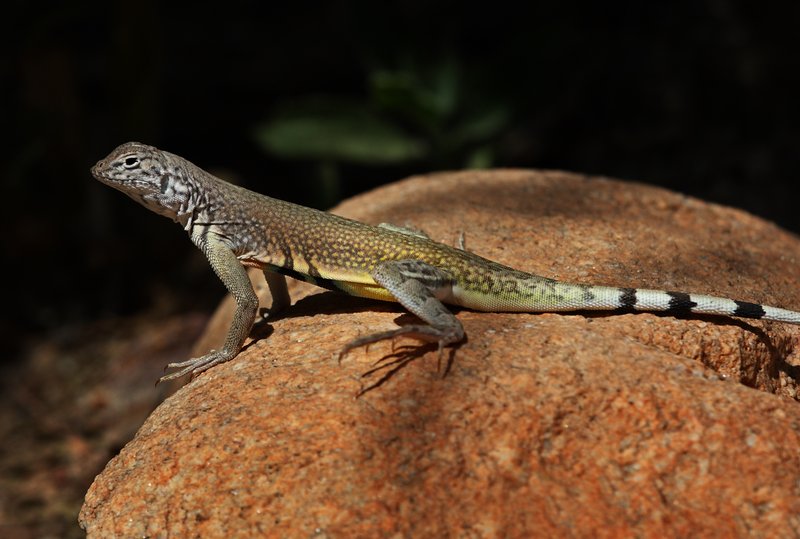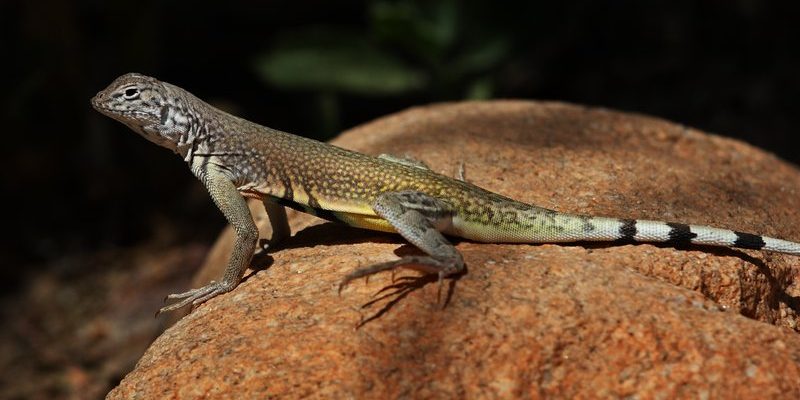
Meet the Zebra-Tailed Lizard, a true gem of the desert landscape. Picture this: a small lizard, no longer than a pencil, with striking black and white stripes that paint its tail like nature’s very own artwork. This little creature isn’t just about looks; it’s also a master of survival in the harsh climates of the Southwestern United States. If you’ve ever wondered how such a vibrant animal thrives in such dry places, you’re in the right spot.
These lizards are not just eye candy; they play important roles in their ecosystems. Known for their agility and unique behaviors, the Zebra-Tailed Lizard captivates both casual observers and dedicated herpetologists. Their distinctive tail isn’t just for show—it helps them evade predators while they dart across sandy dunes and rocky outcrops. Understanding these fascinating little reptiles enhances our appreciation of the diversity of life around us.
Physical Characteristics
The Zebra-Tailed Lizard is quite the sight to behold. Typically measuring around 5 to 10 inches long, their bodies are slender and streamlined, perfect for their agile lifestyle. The most striking feature is, of course, that tail—patterned with bold black and white stripes that give these lizards their name. But why such a flamboyant display? It’s not just for aesthetics; this tail acts like a flag, distracting would-be predators while they make a quick getaway.
Another interesting aspect of their appearance is their coloration. The body is often a sandy or brownish hue, which helps them blend seamlessly into their desert surroundings, offering excellent camouflage. When threatened, they can quickly pivot their tail, making it a blur against the sandy background, enhancing their chance of escape. Additionally, their sharp limbs and long toes are adapted for climbing, allowing them to navigate rocky terrains with ease. You might say they are the “acrobats” of their habitat!
Habitat and Distribution
Zebra-Tailed Lizards are commonly found in the arid regions of the southwestern United States, particularly in parts of Arizona, New Mexico, and California. They thrive in sandy or rocky areas, often spotted basking on warm rocks or darting across sun-soaked surfaces. Their preferred habitats include desert scrub, grasslands, and even the fringes of urban environments where they can find shelter.
These lizards are highly adaptive, but they can’t survive just anywhere. They prefer areas with plenty of sunshine and sparse vegetation, which allows them to hunt for insects and other small invertebrates. If you ever trek through the desert, keep an eye out for these little guys! You might spot them soaking up the sun, their tail flicking in the breeze as they soak in the warmth.
Behavior and Diet
The Zebra-Tailed Lizard is known for its lively and active behavior. They are diurnal, meaning they’re most active during the day, which is when they hunt for food. Their diet mainly consists of insects such as crickets, beetles, and grasshoppers—basically, they’re little hunters in a vast, sandy landscape. Their agility and speed make them excellent at catching their prey, and they can dart swiftly between rocks and shrubs.
When it comes to social behavior, they can often be seen basking together in the sun, which is vital for their cold-blooded bodies. They communicate through a variety of body movements, flashing their tails and performing little dances to signal their presence. This behavior also plays a role in courtship during the breeding season, showcasing their fitness and vitality to potential mates.
Reproduction and Lifespan
Zebra-Tailed Lizards have an interesting reproductive cycle. Mating typically occurs in the spring when temperatures begin to rise. After mating, females lay clutches of eggs—usually between 4 to 10—into sandy soil or soft ground, where they can remain safe from predators. The eggs hatch after about one to two months, and the tiny hatchlings are miniature versions of their parents, ready to start their lives in the desert.
In terms of lifespan, these lizards can live up to 5 years in the wild, although some may survive longer in captivity under ideal conditions. The challenges of their natural environment—predators, harsh climate, and limited food resources—can impact their longevity. Nonetheless, their fascinating lives and vibrant behaviors make them a treasure in the animal kingdom.
Conservation Status
Currently, the Zebra-Tailed Lizard is not considered endangered, but their habitat is under threat from urban development and climate change. As human activities continue to encroach on their environments, these lizards face challenges in finding suitable places to live and thrive. Conservation efforts are crucial to maintain their populations and the delicate ecosystems they inhabit.
Understanding the role of the Zebra-Tailed Lizard in its habitat can help underline the importance of preserving desert ecosystems. Each creature plays a part in the balance of our environment, and when one is threatened, it can have ripple effects throughout the ecosystem. Taking steps to protect their habitats can help ensure that these vibrant lizards continue to scurry across the sands for generations to come.
Interesting Facts
| Common Name: | Zebra-Tailed Lizard |
| Scientific Name: | Ctenosaura pectinata |
| Size: | 5 to 10 inches (including tail) |
| Habitat: | Desert regions of the southwestern USA |
| Diet: | Insects and small invertebrates |
| Lifespan: | Up to 5 years in the wild |
| Conservation Status: | Least Concern |
How to Spot a Zebra-Tailed Lizard
If you’re eager to catch a glimpse of the Zebra-Tailed Lizard, there are a few tips that might help. First, visit their natural habitats during the day, particularly early morning or late afternoon when they are most active. Look for them basking on rocks or darting across sandy patches. Their distinctive tail makes them easier to spot, so keep your eyes peeled for that striking black and white pattern.
Being observant is key! These lizards are quick and often skitter away at the slightest hint of disturbance. They’re more inclined to stay visible when basking, so patience is your best friend. Bring binoculars for a closer look without startling them. If you’re in the southwestern U.S. during warmer months, you definitely have a good chance of encountering them.
In the grand tapestry of desert life, the Zebra-Tailed Lizard stands out, not just for its beauty but also for its resilience. These lizards teach us about adaptation and survival in some of the Earth’s most challenging environments. So the next time you find yourself near the desert, take a moment to appreciate these little acrobats, flashing their striking tails as they navigate their sun-drenched world.
FAQ
What do Zebra-Tailed Lizards eat?
Zebra-Tailed Lizards primarily feast on insects like crickets, beetles, and grasshoppers. Their diet is crucial for their growth and energy, allowing them to dart around in their sandy habitats. They have great hunting skills and often catch their prey with quick, agile movements. Ensuring they have a diverse diet helps maintain their health in the wild.
How do Zebra-Tailed Lizards adapt to their hot environment?
These lizards are perfectly adapted to the desert heat. They utilize behavioral adaptations, like basking in the sun to regulate their body temperature. When it gets too hot, they will seek shelter in vegetation or burrows to avoid overheating. Their coloration also plays a role; the lighter shades of their body help reflect sunlight, keeping them cooler.
Can Zebra-Tailed Lizards change color?
While Zebra-Tailed Lizards do not change color like chameleons, their coloration can appear slightly different based on their environment and temperature. The lighter base color allows them to blend in with sandy backgrounds, which is crucial for avoiding predators. However, they maintain their striking appearance through their black-and-white striped tails and patterned bodies.
Are Zebra-Tailed Lizards social animals?
Yes, they can be quite social, especially during basking periods when they might be seen together on warm rocks. While they do exhibit territorial behavior during the breeding season, it’s not uncommon to see them sharing space, particularly in favorable conditions. Their communication through body language adds an interesting social dynamic to their interactions.
How long do Zebra-Tailed Lizards live in captivity?
In captivity, with proper care, Zebra-Tailed Lizards can live longer than in the wild—up to 7 to 10 years. In a controlled environment, where they have a stable diet and protection from predators, they experience a reduced stress level, which contributes to their longevity. Providing the right habitat and diet is crucial for their well-being.
What threats do Zebra-Tailed Lizards face?
While currently not endangered, Zebra-Tailed Lizards face threats primarily from habitat destruction due to urban development and climate change. As their natural habitats diminish, their populations can decline. Conservation efforts are vital to preserve their environments and ensure these fascinating reptiles can thrive in the wild.
What is the best way to observe Zebra-Tailed Lizards?
The best way to observe Zebra-Tailed Lizards is by visiting their natural habitats during the daytime. Early morning or late afternoon are ideal times when they are most active. Be patient and quiet, and look for them basking in the sun or scurrying across the landscape. Binoculars can enhance your viewing experience without disturbing them.
Do Zebra-Tailed Lizards have any predators?
Yes, like many reptiles, Zebra-Tailed Lizards face threats from various predators, including birds of prey, snakes, and larger mammals. Their instinct for quick movements and camouflage helps them evade these threats. The ability to quickly distract predators with their tails gives them a crucial advantage in the wild.
How can I help protect Zebra-Tailed Lizards?
You can help protect Zebra-Tailed Lizards by supporting conservation efforts that aim to preserve their habitats. This can include advocating for sustainable land use and habitat restoration projects. Additionally, educating others about the importance of these lizards and their ecosystems can raise awareness and promote preservation initiatives.
Are Zebra-Tailed Lizards kept as pets?
Yes, some people do keep Zebra-Tailed Lizards as pets. However, they require specific care, including a suitable habitat that mimics their natural environment, a proper diet, and appropriate temperatures for basking. If you’re considering one as a pet, it’s important to research thoroughly and ensure you can provide a suitable home for these lively lizards.
Is the Zebra-Tailed Lizard endangered?
The Zebra-Tailed Lizard is currently classified as Least Concern, indicating that it is not endangered at this time. However, conservationists keep a close eye on their populations and habitats. While they are not widely threatened, ongoing habitat loss could impact their numbers, making preservation efforts crucial for their continued survival in the wild.
What is the significance of the tail in Zebra-Tailed Lizards?
The tail of the Zebra-Tailed Lizard serves multiple purposes, from aiding in balance when climbing to providing vital camouflage. Its distinctive black and white stripes help distract predators, which can be crucial for evading capture. Additionally, the tail helps them navigate the sandy terrain, making it an essential adaptation for their survival.

